| Contents
Home
General
Info
Ordering
Info
Contact us
Cartridge
Lists
Patent & Miscellaneous
Rim Fire
Center Fire Pistol
Center Fire Rifle
Metric Rimfire,
Pistol&Rifle
British Pistol and Rifle
Shotgun Shells
Posters
This Month's Picture Page
Prior Picture Pages:
*
September 2003
*
October 2003
*
November 2003
*
December 2003
*
January 2004
*
February 2004
*
March 2004
*
April 2004
*
May 2004
*
June 2004
*
July 2004
*
August 2004
*
September 2004
*
October 2004
*
November 2004
*
December
2004
*
January 2005
*
February
2005
*
March
2005
*
April
2005
*
May 2005
*
June 2005
Links to Other Sites
Cartridge Collectors Organizations:
IAA
ECRA
SAAACA
Auctions:
Auction
Arms
E-Bay
Ward's Collectibles
Sold USA
Books:
Armory
Publications
WCF Publications
Other Collector's Sites:
Curtis Steinhauer
|
Home of the Old Ammo Guy's Virtual
Cartridge Trading Table
Featuring a wide range of antique,
obsolete, and modern ammunition for collectors
Picture
Page
June
2005
An assortment of Gaupillat-Collette
cartridges....
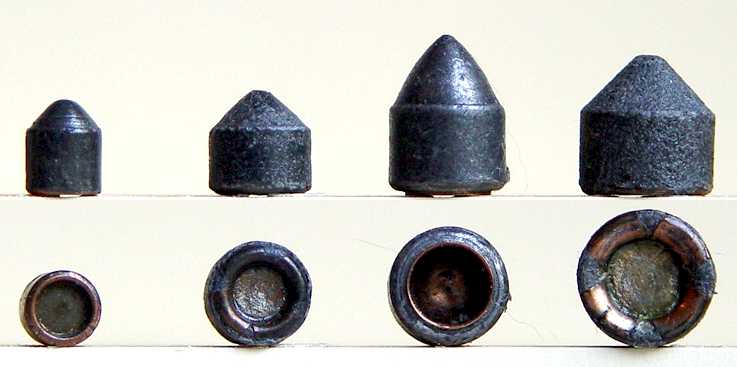
In 1854, a Frenchman named Gaupillat received a patent for a
cartridge that consisted of a hollow bullet with an inverted percussion cap
inserted in the hollow. I believe this is the same Gaupillat who was a
partner in the French ammunition company Gevelot & Gaupillat that used the
back-to-back 'GG' monogram headstamp. Like the Volcanic cartridge, the hollowed bullet of the
Gaupillat cartridge acted as the case, but unlike the Volcanic, there was no
powder charge used; the explosion of the primer was all that propelled the
bullet.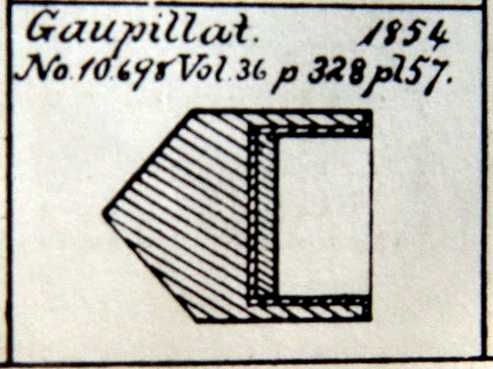 It was a very simple design, as is obvious from the patent drawing shown
here, and likely met with little enthusiasm due to its lack of stopping
power. The cartridges were produced in the four sizes shown in the picture:
6mm, 8mm, 10mm and 11.2mm. The second and fourth examples in the picture
closely match the cartridge in the patent drawing, and the latter of the two
appears to be fitted with a common military top hat style musket cap. I
would assume that the percussion caps used for all of these not specially
made, but were nothing more than the standard caps in production at that
time. With that empty space in the cartridge, you can bet that
it didn't take long for some creative shooter, in search of a little excitement,
to
It was a very simple design, as is obvious from the patent drawing shown
here, and likely met with little enthusiasm due to its lack of stopping
power. The cartridges were produced in the four sizes shown in the picture:
6mm, 8mm, 10mm and 11.2mm. The second and fourth examples in the picture
closely match the cartridge in the patent drawing, and the latter of the two
appears to be fitted with a common military top hat style musket cap. I
would assume that the percussion caps used for all of these not specially
made, but were nothing more than the standard caps in production at that
time. With that empty space in the cartridge, you can bet that
it didn't take long for some creative shooter, in search of a little excitement,
to 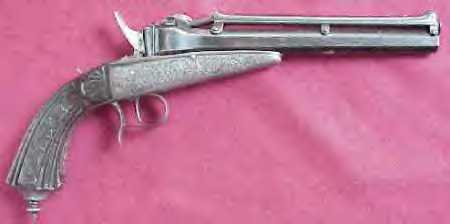 add
a few grains of powder, seal the base with wax, and proceed to blow up his
pistol with the resulting magnum load. I've included a couple of pictures of
one of the pistols that used the Gaupillat cartridge; this is a Colette
patent pistol made in Leige, Belgium. These pictures are from Horst Held's
superb web site at www.horstheld.com.
The pistol is loaded by dropping the lever which raises the breechblock up
to the magazine that is located on top of the barrel. Tipping the pistol
back drops one of the cartridges into the chamber that is on the front side
of the breechblock. Lowering the add
a few grains of powder, seal the base with wax, and proceed to blow up his
pistol with the resulting magnum load. I've included a couple of pictures of
one of the pistols that used the Gaupillat cartridge; this is a Colette
patent pistol made in Leige, Belgium. These pictures are from Horst Held's
superb web site at www.horstheld.com.
The pistol is loaded by dropping the lever which raises the breechblock up
to the magazine that is located on top of the barrel. Tipping the pistol
back drops one of the cartridges into the chamber that is on the front side
of the breechblock. Lowering the
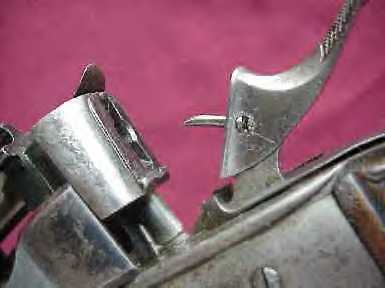 breechblock
brings the cartridge in line with the barrel, ready to be ignited by the
long, pointed firing pin attached to the hammer. breechblock
brings the cartridge in line with the barrel, ready to be ignited by the
long, pointed firing pin attached to the hammer.
>
>
>
>
Another 5.56 x 45mm to add to the collection
.......
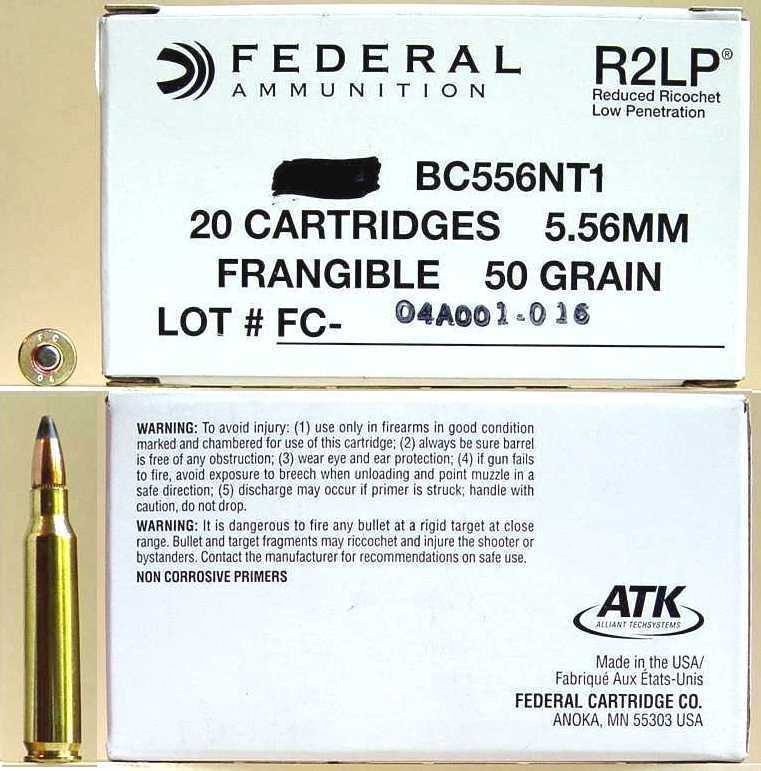 Federal Cartridge Company,
part of the ATK Ammunition Group, produced this box of frangible ammunition
at its manufacturing facility in Anoka, Minn. ATK (Alliant Techsystems), the
largest manufacturer of ammunition in the country, was awarded a contract from the Naval
Surface Warfare Center, Crane Division, Crane, Ind., to produce 5.56mm
frangible ammunition to meet U. S. Air Force and U. S. Marine Corps training
requirements. Federal Cartridge Company is one of five businesses that form
the Ammunition and Related Products operating unit within the ATK Ammunition
Group, and produces small caliber ammunition and related products for
military, law enforcement, and commercial markets. Frangible ammunition is
designed to break apart Federal Cartridge Company,
part of the ATK Ammunition Group, produced this box of frangible ammunition
at its manufacturing facility in Anoka, Minn. ATK (Alliant Techsystems), the
largest manufacturer of ammunition in the country, was awarded a contract from the Naval
Surface Warfare Center, Crane Division, Crane, Ind., to produce 5.56mm
frangible ammunition to meet U. S. Air Force and U. S. Marine Corps training
requirements. Federal Cartridge Company is one of five businesses that form
the Ammunition and Related Products operating unit within the ATK Ammunition
Group, and produces small caliber ammunition and related products for
military, law enforcement, and commercial markets. Frangible ammunition is
designed to break apart
 into small pieces upon contact with hard targets to
reduce ricochets and limit penetration. It is non - toxic and lead - free,
eliminating hazardous exposure for the user and reducing environmental cleanup costs for training ranges.
The tip of the bullet is composed of a powdered copper material. The
headstamp is FC 04, indicating production on 2004. into small pieces upon contact with hard targets to
reduce ricochets and limit penetration. It is non - toxic and lead - free,
eliminating hazardous exposure for the user and reducing environmental cleanup costs for training ranges.
The tip of the bullet is composed of a powdered copper material. The
headstamp is FC 04, indicating production on 2004.
>
>
A variety of loads in a common headstamp.....
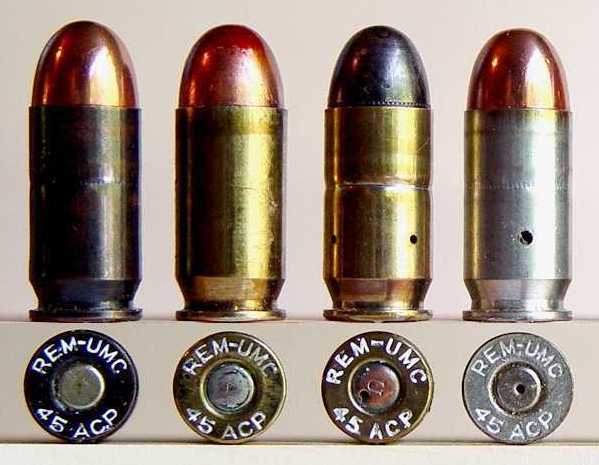
Even among the commonest of headstamps, there is a variety of
desirable examples to be on the lookout for. Such is the case with REM-UMC
headstamped .45 automatic cartridges. Shown here, beginning on the left in
the first picture is a blackened case proof load. This is followed by a
tracer load, with its red-nosed bullet, and a couple of dummies, the first
with a blackened bullet and the second with a tinned case. The first
cartridge in the second picture is a riot load. The bullet on this one
consists of a round lead ball on top of three lead discs which fit into the
copper jacket; these are supposed to break apart on firing, making it less
lethal. While this bullet has a slightly more blunt profile, it is still
difficult to tell that it is anything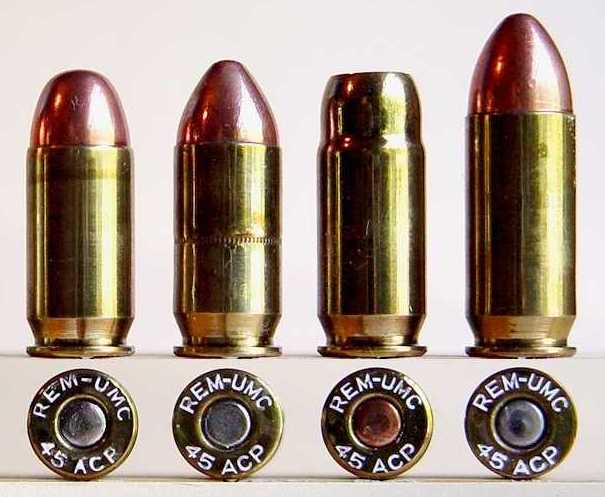 unusual from its outward appearance. However, it is easily identified by the rattle the ball
makes in the
jacket when the cartridge is shaken. The second cartridge has a semi-pointed
175 grain metal piercing bullet, sold by Remington under the brand name
Hi-Way Master, and intended for law enforcement use. The third cartridge is
a shot load with a paper wad at the case mouth. The last cartridge is the
Remington-Thompson .45 with a longer than standard case, intended for use by
the military in Thompson sum-machine guns that have been fitted with a
special box magazine.
unusual from its outward appearance. However, it is easily identified by the rattle the ball
makes in the
jacket when the cartridge is shaken. The second cartridge has a semi-pointed
175 grain metal piercing bullet, sold by Remington under the brand name
Hi-Way Master, and intended for law enforcement use. The third cartridge is
a shot load with a paper wad at the case mouth. The last cartridge is the
Remington-Thompson .45 with a longer than standard case, intended for use by
the military in Thompson sum-machine guns that have been fitted with a
special box magazine.
>
>
|


 It was a very simple design, as is obvious from the patent drawing shown
here, and likely met with little enthusiasm due to its lack of stopping
power. The cartridges were produced in the four sizes shown in the picture:
6mm, 8mm, 10mm and 11.2mm. The second and fourth examples in the picture
closely match the cartridge in the patent drawing, and the latter of the two
appears to be fitted with a common military top hat style musket cap. I
would assume that the percussion caps used for all of these not specially
made, but were nothing more than the standard caps in production at that
time. With that empty space in the cartridge, you can bet that
it didn't take long for some creative shooter, in search of a little excitement,
to
It was a very simple design, as is obvious from the patent drawing shown
here, and likely met with little enthusiasm due to its lack of stopping
power. The cartridges were produced in the four sizes shown in the picture:
6mm, 8mm, 10mm and 11.2mm. The second and fourth examples in the picture
closely match the cartridge in the patent drawing, and the latter of the two
appears to be fitted with a common military top hat style musket cap. I
would assume that the percussion caps used for all of these not specially
made, but were nothing more than the standard caps in production at that
time. With that empty space in the cartridge, you can bet that
it didn't take long for some creative shooter, in search of a little excitement,
to  add
a few grains of powder, seal the base with wax, and proceed to blow up his
pistol with the resulting magnum load. I've included a couple of pictures of
one of the pistols that used the Gaupillat cartridge; this is a Colette
patent pistol made in Leige, Belgium. These pictures are from Horst Held's
superb web site at
add
a few grains of powder, seal the base with wax, and proceed to blow up his
pistol with the resulting magnum load. I've included a couple of pictures of
one of the pistols that used the Gaupillat cartridge; this is a Colette
patent pistol made in Leige, Belgium. These pictures are from Horst Held's
superb web site at  breechblock
brings the cartridge in line with the barrel, ready to be ignited by the
long, pointed firing pin attached to the hammer.
breechblock
brings the cartridge in line with the barrel, ready to be ignited by the
long, pointed firing pin attached to the hammer.  Federal Cartridge Company,
part of the ATK Ammunition Group, produced this box of frangible ammunition
at its manufacturing facility in Anoka, Minn. ATK (Alliant Techsystems), the
largest manufacturer of ammunition in the country, was awarded a contract from the Naval
Surface Warfare Center, Crane Division, Crane, Ind., to produce 5.56mm
frangible ammunition to meet U. S. Air Force and U. S. Marine Corps training
requirements. Federal Cartridge Company is one of five businesses that form
the Ammunition and Related Products operating unit within the ATK Ammunition
Group, and produces small caliber ammunition and related products for
military, law enforcement, and commercial markets. Frangible ammunition is
designed to break apart
Federal Cartridge Company,
part of the ATK Ammunition Group, produced this box of frangible ammunition
at its manufacturing facility in Anoka, Minn. ATK (Alliant Techsystems), the
largest manufacturer of ammunition in the country, was awarded a contract from the Naval
Surface Warfare Center, Crane Division, Crane, Ind., to produce 5.56mm
frangible ammunition to meet U. S. Air Force and U. S. Marine Corps training
requirements. Federal Cartridge Company is one of five businesses that form
the Ammunition and Related Products operating unit within the ATK Ammunition
Group, and produces small caliber ammunition and related products for
military, law enforcement, and commercial markets. Frangible ammunition is
designed to break apart
 into small pieces upon contact with hard targets to
reduce ricochets and limit penetration. It is non - toxic and lead - free,
eliminating hazardous exposure for the user and reducing environmental cleanup costs for training ranges.
The tip of the bullet is composed of a powdered copper material. The
headstamp is FC 04, indicating production on 2004.
into small pieces upon contact with hard targets to
reduce ricochets and limit penetration. It is non - toxic and lead - free,
eliminating hazardous exposure for the user and reducing environmental cleanup costs for training ranges.
The tip of the bullet is composed of a powdered copper material. The
headstamp is FC 04, indicating production on 2004.
 unusual from its outward appearance. However, it is easily identified by the rattle the ball
makes in the
jacket when the cartridge is shaken. The second cartridge has a semi-pointed
175 grain metal piercing bullet, sold by Remington under the brand name
Hi-Way Master, and intended for law enforcement use. The third cartridge is
a shot load with a paper wad at the case mouth. The last cartridge is the
Remington-Thompson .45 with a longer than standard case, intended for use by
the military in Thompson sum-machine guns that have been fitted with a
special box magazine.
unusual from its outward appearance. However, it is easily identified by the rattle the ball
makes in the
jacket when the cartridge is shaken. The second cartridge has a semi-pointed
175 grain metal piercing bullet, sold by Remington under the brand name
Hi-Way Master, and intended for law enforcement use. The third cartridge is
a shot load with a paper wad at the case mouth. The last cartridge is the
Remington-Thompson .45 with a longer than standard case, intended for use by
the military in Thompson sum-machine guns that have been fitted with a
special box magazine.